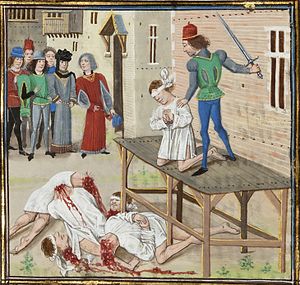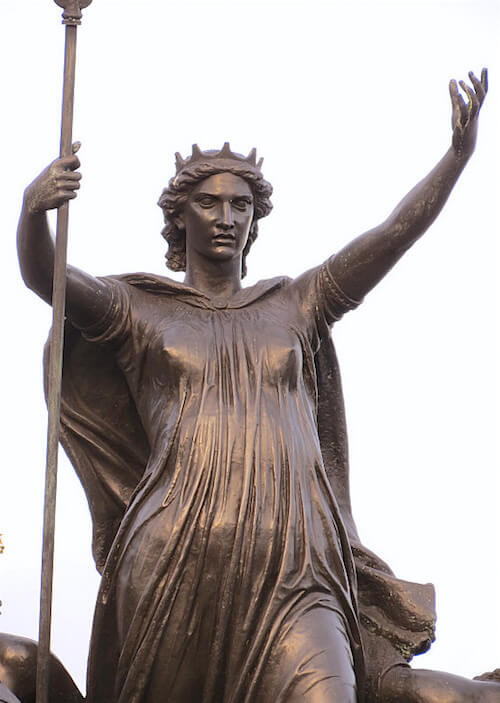Shrouded in mythology, Jeanne de Clisson was one of the bloodiest privateers of the 14th century. Born a wealthy lady of high rank, Jeanne took to the seas against the French after the execution of her much loved second husband Olivier. She proceeded to harry French ships--militaristic and merchant--on behalf of the English crown for 13 years before settling down into another happy marriage.
Born Jeanne de Belleville, Jeanne was born in 1300, and married wealthy land owner Geoffrey de Chateaubriant at the age of 12. Very little is known about Jeanne's first marriage, but she did have two children with Geoffrey--a son and a daughter. The son would inherit the Chateaubriant estate after Geoffrey's death in 1326, and the daughter would later inherit the de Belleville estate, as Jeanne had no living brothers.
Jeanne married again in 1330, this time to Olivier de Clisson, a widower and great friend of Charles de Blois. Though neither left a diary saying 'I <3 Jeanne/Olivier', tradition holds that their marriage was a love match. They would have five children together and live happily for 13 years.
The political situation of the time was more than tense. France and England were having at it (when were they not?), this time over Brittany, a northern Duchy in what is now France. At the time, the English still had extensive holdings in modern France, inherited from Eleanor of Aquitaine. The English, however, were having difficulties holding onto those territories, and had been at war with France off and on for several hundred years.
At Jeanne's time, England and France were involved in what would come to be called the Hundred Year's War, the same war which Jeanne d'Arc would fight and die in. (Remember, this is the HUNDRED Years war.) The war was over possession of Brittany, the territory in which Jeanne lived. Formerly an independent Celtic state, Brittany had become an independent Duchy. It was technically beholden to no other country, but had the misfortune to be surrounded by two major powers who were constantly trying to take it over. Brittany managed to hold strong until 1341 when Duke John of Brittany died without a direct heir.
The duke's death left two potential heirs to the Duchy, one backed by the French, another backed by the English. As was usual with such land disputes, France and England merrily began another war, hacking away at each other's populations and infrastructures mercilessly. Olivier, as a friend of Charles de Blois, the French candidate for the Duchy, was called away to command in the war, being posted at a fort in Vannes.
During the siege of Vannes Olivier was taken captive by the English. He was later released in a prisoner exchange, but his friend Charles de Blois was suspicious. Charles suspected that the English had had French help when they took Vannes, and he suspected Olivier. He condemned Olivier for treason, and had him executed without trial in August of 1343. Olivier's head was sent to Nantes, and placed on a spike above the city.
Jeanne was, understandably, distraught.She took her sons to see their father's decapitated head, and told them that he had been murdered by Charles de Blois. Shortly after, she sold all of her land, and gathered a force of men loyal to her and Olivier's memory. With her men she set off on a revenge mission that would last nearly two decades.
First stop on the revenge tour was the castle of Galois de la Heuse. Galois was a supporter of Charles de Blois, and had been friendly with Jeanne's husband. Why Jeanne chose Galois' home for her first scene of revenge is uncertain, but what is known is that Galois never saw it coming. He opened the gates to let Jeanne in, and was, presumably, quite surprised to soon find himself and most of the people who lived there slaughtered. Jeanne's force left a few survivors to spread the news, then took to the seas where they could make the most impact.
With money from the sales of her lands, Jeanne purchased three ships. They were painted black, and outfitted with red sails. The sight of those ships struck fear into the hearts of many a sailor when Jeanne and her crew overtook unsuspecting French ships in the mist on the English Channel. Those ominous ships meant almost certain death to almost everyone on board the captured vessel. Jeanne only spared one or two members of each crew so there would be a survivor to carry tales of her exploits.
Noble status didn't protect seafarers from Jeanne's crew. Jeanne had a particular hatred for members of the nobility, and legend had it that she would behead noblemen herself. This, combined with her general modus operandi, earned her the ephitet 'Bloody Lioness of Brittany'.
Jeanne wasn't a simple pirate motivated by self interest. She was a privateer. She colluded with the English crown to provide supplies to their troops in France, and to destroy French ships. She received ships and men from the English government, and became an integral part of English naval strategy.
In 1356 Jeanne quit the murder on the high seas business, and married again, this time to Englishman Walter Bentley. Once again, all signs point to this marriage being a love match. The pair moved to a castle near the coast of Brittany, and lived peacefully. Jeanne died quietly in 1359.
Today Jeanne is all but forgotten, and the few stories we have about her are romanticized with myth and legend. It is difficult to say which parts of her life are true and which are fiction, but what few concrete records we have of her paint a vivid picture of a strong woman unafraid to get her hands dirty (or, you know, murder someone.)
Sources
Jeanne de Clisson
The Lioness of Brittany
Jeanne de Clisson, the Bloody Lioness of Brittany
 |
| Modern picture of Jeanne done in the artistic style of the time. It is unknown exactly what Jeanne looked like. |
Jeanne married again in 1330, this time to Olivier de Clisson, a widower and great friend of Charles de Blois. Though neither left a diary saying 'I <3 Jeanne/Olivier', tradition holds that their marriage was a love match. They would have five children together and live happily for 13 years.
The political situation of the time was more than tense. France and England were having at it (when were they not?), this time over Brittany, a northern Duchy in what is now France. At the time, the English still had extensive holdings in modern France, inherited from Eleanor of Aquitaine. The English, however, were having difficulties holding onto those territories, and had been at war with France off and on for several hundred years.
At Jeanne's time, England and France were involved in what would come to be called the Hundred Year's War, the same war which Jeanne d'Arc would fight and die in. (Remember, this is the HUNDRED Years war.) The war was over possession of Brittany, the territory in which Jeanne lived. Formerly an independent Celtic state, Brittany had become an independent Duchy. It was technically beholden to no other country, but had the misfortune to be surrounded by two major powers who were constantly trying to take it over. Brittany managed to hold strong until 1341 when Duke John of Brittany died without a direct heir.
The duke's death left two potential heirs to the Duchy, one backed by the French, another backed by the English. As was usual with such land disputes, France and England merrily began another war, hacking away at each other's populations and infrastructures mercilessly. Olivier, as a friend of Charles de Blois, the French candidate for the Duchy, was called away to command in the war, being posted at a fort in Vannes.
 |
| Olivier kneels on the scaffold, awaiting his death. He is surrounded by the corpses of other noblemen executed for treason. |
Jeanne was, understandably, distraught.She took her sons to see their father's decapitated head, and told them that he had been murdered by Charles de Blois. Shortly after, she sold all of her land, and gathered a force of men loyal to her and Olivier's memory. With her men she set off on a revenge mission that would last nearly two decades.
First stop on the revenge tour was the castle of Galois de la Heuse. Galois was a supporter of Charles de Blois, and had been friendly with Jeanne's husband. Why Jeanne chose Galois' home for her first scene of revenge is uncertain, but what is known is that Galois never saw it coming. He opened the gates to let Jeanne in, and was, presumably, quite surprised to soon find himself and most of the people who lived there slaughtered. Jeanne's force left a few survivors to spread the news, then took to the seas where they could make the most impact.
With money from the sales of her lands, Jeanne purchased three ships. They were painted black, and outfitted with red sails. The sight of those ships struck fear into the hearts of many a sailor when Jeanne and her crew overtook unsuspecting French ships in the mist on the English Channel. Those ominous ships meant almost certain death to almost everyone on board the captured vessel. Jeanne only spared one or two members of each crew so there would be a survivor to carry tales of her exploits.
Noble status didn't protect seafarers from Jeanne's crew. Jeanne had a particular hatred for members of the nobility, and legend had it that she would behead noblemen herself. This, combined with her general modus operandi, earned her the ephitet 'Bloody Lioness of Brittany'.
 |
| Brittany on a map of modern France. |
In 1356 Jeanne quit the murder on the high seas business, and married again, this time to Englishman Walter Bentley. Once again, all signs point to this marriage being a love match. The pair moved to a castle near the coast of Brittany, and lived peacefully. Jeanne died quietly in 1359.
Today Jeanne is all but forgotten, and the few stories we have about her are romanticized with myth and legend. It is difficult to say which parts of her life are true and which are fiction, but what few concrete records we have of her paint a vivid picture of a strong woman unafraid to get her hands dirty (or, you know, murder someone.)
Sources
Jeanne de Clisson
The Lioness of Brittany
Jeanne de Clisson, the Bloody Lioness of Brittany


